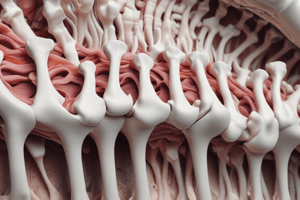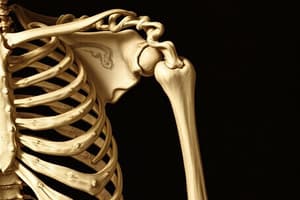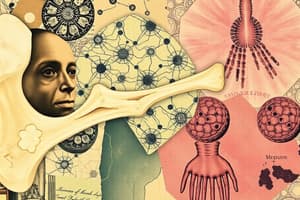Podcast
Questions and Answers
What is the structural unit of compact bone?
What is the structural unit of compact bone?
- Osteoclasts
- Lamellae
- Osteon (correct)
- Haversian canal
What are lamellae?
What are lamellae?
Concentric rings of bone matrix
What is the function of the Haversian canal?
What is the function of the Haversian canal?
It contains a network of blood vessels and nerves running through compact bone.
What do Volkmann canals connect?
What do Volkmann canals connect?
Osteoclasts consume and reabsorb old bones.
Osteoclasts consume and reabsorb old bones.
Osteoblasts are responsible for consuming bone.
Osteoblasts are responsible for consuming bone.
What are osteogenic cells?
What are osteogenic cells?
What is the osteoid?
What is the osteoid?
What are lacunae?
What are lacunae?
What are canaliculi?
What are canaliculi?
What are chondrocytes?
What are chondrocytes?
What is the primary function of hyaline cartilage?
What is the primary function of hyaline cartilage?
What is the role of elastic cartilage?
What is the role of elastic cartilage?
What is the primary function of fibrous cartilage?
What is the primary function of fibrous cartilage?
What connects bone to bone?
What connects bone to bone?
What connects muscle to bone?
What connects muscle to bone?
What germ layer is the precursor for connective tissue?
What germ layer is the precursor for connective tissue?
Muscle tissue is responsible for involuntary movement.
Muscle tissue is responsible for involuntary movement.
Nervous tissue is derived from the endoderm.
Nervous tissue is derived from the endoderm.
What is the function of epithelial tissue?
What is the function of epithelial tissue?
What characterizes a resting sarcomere that can generate the greatest amount of contractile force?
What characterizes a resting sarcomere that can generate the greatest amount of contractile force?
Flashcards are hidden until you start studying
Study Notes
Bone Structure and Function
- Osteon, or Haversian System, is the structural unit of compact bone.
- Lamellae are concentric rings of bone matrix.
- Haversian canals contain networks of blood vessels and nerves, allowing communication within compact bone.
- Volkmann canals connect Haversian canals, facilitating nutrient exchange between osteons.
- Osteoclasts reabsorb old bone tissue, playing a crucial role in bone remodeling.
- Osteoblasts are responsible for the formation and mineralization of bone.
- Osteogenic cells are actively dividing stem cells in bone that differentiate into osteoblasts.
- Osteoid is the unmineralized bone matrix composed primarily of proteoglycans, glycoproteins, and collagen.
- Lacunae are small cavities in bone that house osteocytes, which become inactive when trapped in these spaces.
- Canaliculi are hairlike canals that link lacunae and connect them to the central Haversian canal.
Cartilage Types and Functions
- Chondrocytes are the cells that comprise cartilage.
- Hyaline cartilage is the most prevalent type, reducing friction in joints and allowing bone growth at epiphyseal plates.
- Elastic cartilage offers high flexibility and is found in structures like the external ear.
- Fibrous cartilage limits movement and resists compressive forces, notably in the vertebral discs of the spine.
- Cartilage is a connective tissue made of chondrocytes that secrete an extracellular matrix (EM) called chondrin, containing collagen and proteoglycans.
- Lacks nerves and blood supply, receiving nutrients via diffusion, important for maintaining cartilage health.
Development and Connection
- Endochondral ossification converts hyaline cartilage into bone during fetal development, initially forming the skeleton.
- Ligaments connect bone to bone, providing stability to joints.
- Tendons attach muscles to bones, facilitating movement.
- Connective tissue develops from the mesoderm and supports or protects various body structures.
- Muscle tissue originates from the mesoderm and is responsible for both voluntary and involuntary movements.
- Nervous tissue arises from the ectoderm and is essential for transmitting electrical signals in response to stimuli.
- Epithelial tissue, derived from all three germ layers, lines surfaces and is critical for protection, absorption, and secretion.
Muscle Contraction Mechanics
- A resting sarcomere at optimal length maximizes overlap between myosin and actin filaments.
- This arrangement enhances the potential for contractile force, allowing myosin heads to bind effectively to actin filaments during muscle contraction.
Studying That Suits You
Use AI to generate personalized quizzes and flashcards to suit your learning preferences.




